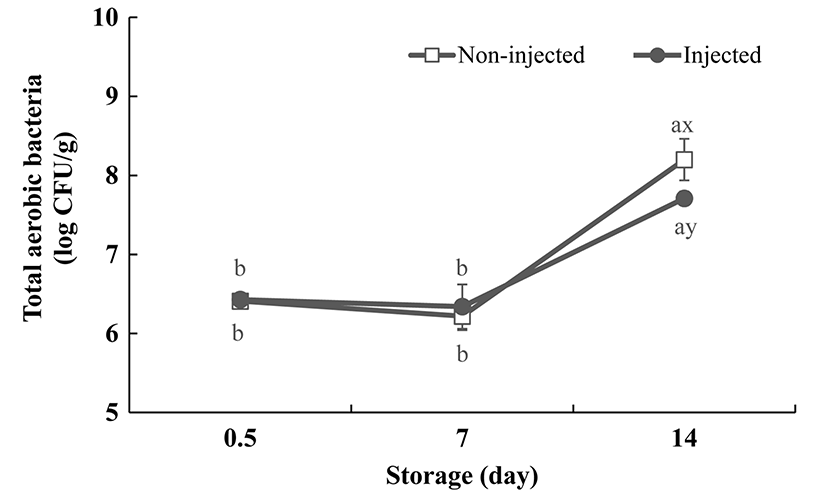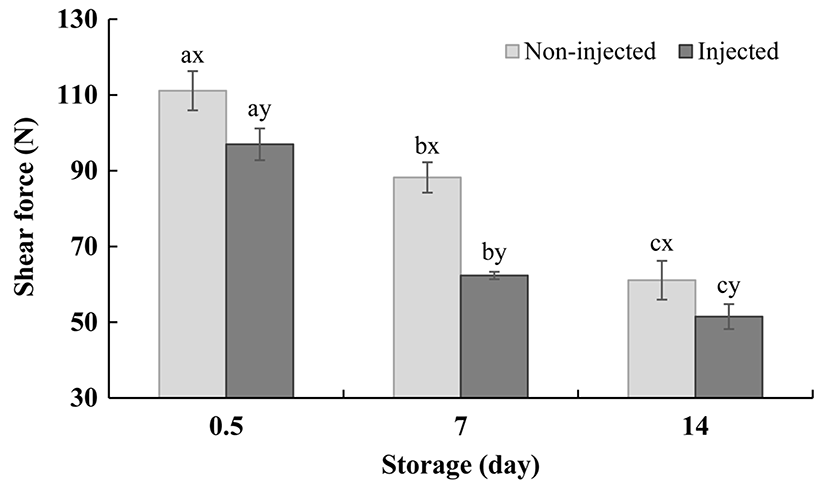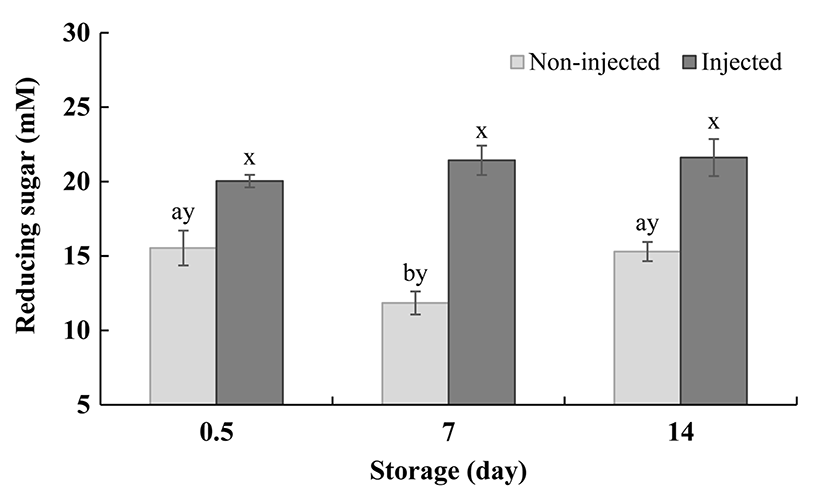Introduction
Korean consumers value tenderness, juiciness, and flavor as the most important attributes of the sensory quality of beef (Lee, 2008). These attributes are closely related to the degree of “marbling,” a term used to describe the amount of intramuscular fat in meat. Marbling loosens the structure of muscle, and the fat stimulates salivary glands in the mouth and enhances flavor intensity (Dinh, 2006). High marbled beef is ranked with high quality grades (QG) of 1++, 1+, and 1 (Lee, 2008), and 92.4% of consumers purchase beef with high QG despite its higher cost (Kim et al., 2014). This biased consumer purchasing behavior can result in potential economic loss to the beef industry because low QG beef accounts for 40% of the total beef production in Korea (KREI, 2014). Therefore, it is important for producers and consumers to increase the consumption of low QG beef; this can potentially be achieved by enhancing the sensory quality of low QG beef.
Various approaches to improve the tenderness and flavor of low marbled beef have been tested, including mechanical pressure processing, aging, marination, and solution injection (Bai and Roh, 2000; Davis et al., 1975; Hoffman, 2006; Lee et al., 2015). Among these methods, injection can induce relatively rapid enhancements in sensory qualities such as tenderness and flavor, and/or antioxidant activity; the efficacy of this approach depends on the precise composition of the injected solution. Meat injected with small amounts of additives in solution is called “enhanced meat” and is sold as fresh meat in the market because the injected solution does not affect its appearance (USDA, 2013). Synthetic additives, which may improve the tenderness and flavor of beef, have also been investigated. Knock et al. (2006) reported that the tenderness of beef strip-loin steaks increased up to 27%, and their flavor was enhanced by injection of 1.5% potassium acetate and 0.1% sodium acetate. Similarly, the addition of 0.4% sodium chloride and tripolyphosphate to beef increased flavor and positive sensory evaluation (Robbins et al., 2003). However, the synthetic additives, used in most studies, are not appealing to Korean consumers because of concerns about the possible health risks of synthetic additives (Lee et al., 2015). Therefore, there is continuous demand for the development of natural additives to popularize enhanced beef and obtain a positive response from Korean consumers.
Pineapple and honey are widely used ingredients in Korean meat dishes. Pineapple is a natural meat tenderizer because of its high content of proteases including bromelain (Bai and Roh, 2000; Ha et al., 2012). Moreover, pineapple contains reducing sugars, which are flavor precursors for the Maillard reaction (Park et al., 1994; Singleton and Gortner, 1965). However, the concentration of pineapple must be optimized in order to prevent excessive disintegration of meat proteins, which may negatively affect meat texture (Bai and Roh, 2000). This limits the use of pineapple alone to enhance meat flavor. Honey can be used as a meat flavor enhancer because it provides sufficient amounts of reducing sugar (Doner, 1977). Honey also contains acidic compounds, including phenolic acids, which may exert antioxidative and antibacterial effects (Pyrzynska and Biesaga, 2009).
Hence, the objectives of this study were to determine whether an injection of pineapple concentrate and honey can enhance the physicochemical and sensory qualities of low marbled beef during storage, and whether the injection possesses antibacterial activity.
Materials and Methods
QG 2 beef loin, from Holstein steer, was purchased from a local market (Korea) and cut into 7 × 6 × 2.7 cm3 pieces (length × width × thickness). Pineapple concentrate (BASE. I.S, Korea), honey (Eden, Korea), monosodium L-glutamate (CJ Cheiljedang Corp., Korea), phosphate (MSC Co., Ltd., Korea), and salt (Hanju Corp., Korea) were purchased for the injection solution. Preliminary experiments were performed to determine the concentrations of each additive. Several concentrations were tested. At optimized conditions, the most effective results were obtained using the lowest concentrations of additives [6.0% pineapple concentrate, 2.5% honey, 0.5% monosodium L-glutamate (MSG), 0.5% phosphate, and 0.3% salt (w/w), Table 1].
| Ingredients | Pineapple concentrate | Honey | MSG* | Phosphate | Salt | Water |
|---|---|---|---|---|---|---|
| Weight (g) | 12.0 | 5.0 | 1.0 | 1.0 | 0.6 | 180.4 |
*MSG, monosodium L-glutamate.
The solution was filtered through a polyvinyl difluoride (PVDF) syringe filter (0.2 μm, Whatman, Inc., UK). The filtrate was injected at the intervals of 2 cm on each slice of beef, which was pumped to 120% of its initial meat weight. Thus, the concentrations of the additives in meat were equivalent to 1/5 of the initial concentration in solution after injection. The control was treated in a similar manner but was not subjected to the injection process. The samples were individually sealed in impermeable polyethylene bags (10 mL/m2·d·MPa, 0.065 mm). The sealed samples were stored for 12 h at 4°C to allow the effects of the additives to occur (0.5 d). Then, the sealed samples were stored for 14 d at 4°C and analyzed for microbial, sensory, and physicochemical characteristics at 7-d intervals (0.5, 7, and 14 d).
We used the method by Kim et al. (2016) with slight modifications. Five grams of each sample was weighed and blended with sterile saline (45 mL, 0.85%, w/w) for 2 min using a laboratory blender (Stomacher BagMixer® 400, Interscience Co., France). After blending, the samples were serially diluted with sterile saline, and each dilution (0.1 mL) was spread on plate count agar (PCA; Difco Laboratories, USA) plates. The PCA plates were incubated at 37°C for 48 h, and microbial counts were expressed as Log colony forming units (CFU)/g meat sample.
The color measurement was assessed using the method by Kim et al. (2016) with slight modifications. The CIE L* (lightness), a* (redness), and b* (yellowness) values of the samples were measured using a calibrated spectrocolorimeter (CM-5, Konica Minolta Sensing Inc., Japan), against black and white tiles, before use. Measurements were obtained perpendicularly to the surface of the meat samples, with illumination area set at the diameter of 3 cm, at three different locations per sample.
We used the shear force measurement by Khan et al. (2016) with slight modifications. For analysis of shear force, meat samples (100 g) were vacuum packed using an impermeable polyethylene bag (HFV-600L, Hankook Fujee Industries Co., Ltd., Korea), cooked in a water bath until the core temperature reached 72°C, and cooled in iced water until they reached room temperature. Cooked samples were cut into equally sized pieces (1 × 1.5 × 4 cm3, thickness × width × length). Values were measured using a Warner-Bratzler shear attachment on a texture analyzer (TA1, Lloyd Instruments Ltd., UK) with a maximum cell load of 10 kg; target load of 10 g; target value of 25 mm; and target speed of 2.0 mm/s. The samples were sheared perpendicularly to the direction of muscle fibers.
We used the method for measuring reducing sugar content by Jayasena et al. (2015) with slight modifications. Sugar was extracted twice from each of the meat samples (1 g) using 5 mL of 80% ethanol at 50°C. The extracts were centrifuged (Continent 512R, Hanil Co., Ltd., Korea) for 10 min at 2,265 g (4°C). The resulting supernatant was filtered (Filter paper No.1, Whatman, Inc., UK) into 15-mL tubes and evaporated using N2 gas (Ultra-pure grade). After evaporation, 2 mL of distilled water was added to each tube and vortexed to dissolve the sugar. This mixture was transferred to a 2-mL microtube and centrifuged at 18,560 g for 10 min at 23°C (HM-150IV, Hanil Co., Ltd., Korea). Subsequently, 1 mL of supernatant was mixed with 2 mL of dinitrosalicylic acid (DNS) solution (0.5 g of DNS, 8.0 g of NaOH, and 150 g of Rochelle salt in 500 mL of distilled water) in a 15-mL tube and heated for 10 min in a water bath set at 90°C. The mixture was cooled under running water for 5 min, and absorbance was measured at 550 nm using a spectrophotometer (X-ma 3100, Human Corp., Korea). Finally, the amount of reducing sugar was calculated using a glucose standard curve (Sigma Aldrich Co. LLC., USA).
We used the sensory evaluation method by Kim et al. (2016) with slight modifications. The sensory evaluation was performed by 10 semi-trained panelists with serial experiences in evaluating the sensory characteristics of injected beef. The samples were cut into identical sizes (2 × 2 ×2 cm3, length × width × thickness), roasted in a pre-heated Teflon-coated pan until the core temperature reached 72°C, and served to the sensory panelists. Color, odor, off-odor, off-taste, tenderness, juiciness, flavor, and overall acceptance were evaluated using a 9-point hedonic scale (1, dislike extremely and 9, like extremely for color, odor, tenderness, juiciness, flavor, and overall acceptance; 1, weak extremely and 9, strong extremely for off-odor and off-taste). These sensory analyses were conducted in three different independent trials.
Statistical analysis was performed using the SAS software (SAS, 2016). Slices from the same retail cut were regarded as random effects, and storage period and application of injection were considered fixed effects. The least square means and variations were calculated using a general linear model. Significant differences among the mean values were identified by the Student-Newman-Keul’s multiple comparison test with a confidence level of p<0.05.
Results and Discussion
In our preliminary study, no difference was found between the non-injected beef and beef injected with MSG (0.5%), phosphate (0.5%), and salt (0.3%); however, combining these additives with pineapple concentrate and honey indicated a significant difference between the injected and non-injected beef (data not shown). Therefore, in this study, we injected the treated samples with the solution including all of these five additives, while the control received no injection.
In this study, no additional contamination of microorganisms was found at 0.5 d after the injection (Fig. 1). Non-injected and injected beef showed similar trends in total bacterial counts during 14 d of storage. Non-injected and injected beef maintained a microbial number less than 7 Log CFU/g until after 7 d of storage, whereas high bacterial counts (>7 Log CFU/g) were observed at 14 d regardless of the injection. According to Hong et al. (2013), this trend may be caused by the initial microbial contamination of beef samples, because bacterial counts in fresh beef are generally less than 3 Log CFU/g. Microbiological food safety is an important issue with respect to injected meat. The process of injecting may cross-contaminate the interior of the meat and accelerate bacterial growth because of the sugar content in pineapple concentrate and honey. However, neither the injection, nor the sugar content of pineapple concentrate and honey, affected the microbial contamination levels and/or microbial growth rate in injected beef as shown by the results of microbial analysis. Indeed, the injection of pineapple concentrate and honey may actually enhance the microbial safety of beef at 14 d as indicated by the significantly lower total aerobic bacterial count compared with that in non-injected beef. Kotzekidou et al. (2008) reported that pineapple extracts suppressed the growth of Escherichia coli O157:H7 EDL-933 because pineapple contains active substances such as terpenoids and phenolic compounds, and these substances attach to bacterial membranes and deplete the metabolic energy of bacteria. Moreover, acidic compounds, including phenolic acid in honey, are positively correlated with antibacterial activity (Pyrzynska and Biesaga, 2009).

There were no significant differences in color (CIE L*, a*, and b*) between the injected and non-injected beef samples at each day of storage, with the exception of CIE b* value at 14 d (Table 2). This indicates that the injection process, using the previously described solution, did not change the appearance of fresh beef. However, the change in color, over extended storage periods, depended on whether the beef was injected or not; the injected beef did not show significant differences in the CIE L*, a*, and b* values, while the non-injected beef showed variations in the CIE a* and b* values during the storage periods. The color stability of injected beef may be attributable to the increased water holding capacity (WHC) and reducing sugar content derived from pineapple concentrate and honey. In contrast with our result, Hoffman (2006) reported that the CIE L* value tended to increase, and CIE a* and b* values tended to decrease, following the addition of a salt mixture containing potassium di- and triphosphates and lactate; this possibly resulted from the loss of myoglobin and light, reflecting from the water on the meat surface, caused by high drip loss (Lee and Choi, 1999). Phosphate is used to enhance WHC; however, its effect is concentration-dependent. Thorarinsdottir et al. (2001) reported that 2% of phosphate increased the WHC of processed meat. However, Hoffman (2006) found that phosphate (3% of total amount in solution) did not affect WHC. El-Kalyoubi et al. (2014) showed that adding honey increased WHC and the cooking yield of chicken slices. Hence, honey may affect color maintenance by decreasing water loss in the injected beef. Color maintenance may also be influenced by the antioxidant effect of reducing sugars in pineapple concentrate and honey, which prevents the oxidation of myoglobin (Dekker et al. 1958).
1Standard errors of means (n=9), 2(n=6).
a,bDifferent letters, within the same row, indicate statistically significant differences (p<0.05).
x,yDifferent letters, within the same column, indicate statistically significant differences (p<0.05).
The injected beef showed a significantly increased tenderness (p<0.05) during the storage periods, indicating a significantly lower shear force compared with that of non-injected beef (Fig. 2). This may be caused by the addition of pineapple concentrate (p<0.0001, F value=74.91) and its abundant content of bromelain (Ketnawa and Rawdkuen, 2011; Ketnawa and Rawdkuen, 2012), which has the highest tenderizing activity among fruit proteases (Ha et al., 2012). Bai and Roh (2000) reported that the shear force value of beef, marinated in a sauce containing pineapple juice, was reduced by up to 66% compared with that of beef marinated without pineapple juice. In this study, the shear force of beef decreased over the storage periods, independently of injection. This similarity in the shear force change between the non-injected and injected beef was likely partially caused by aging (p<0.0001, F value=211.39). The injected sample, stored over the longest period, had the lowest shear force value because of the combined effects of aging and protease (bromelain) activity (p=0.0125). The injection of pineapple concentrate and honey appears to shorten the aging period of beef by approximately a week. This was evidenced by the fact that the shear force values of injected beef, at 0.5 and 7 d, were similar to those of non-injected beef at 7 and 14 d, respectively (Fig. 2).

The injected beef showed significantly higher content of reducing sugar than that of the non-injected beef (Fig. 3). This is because pineapple concentrate and honey, the principal ingredients of the injected solution, are rich in reducing sugars including glucose and fructose (Bai and Roh, 2000; Doner, 1977). Reducing sugars react with amino acids in the Maillard reaction, which imparts the characteristic flavor to many foods including meat (Varavinita et al., 2000). However, in this study, panelists were only able to detect a difference in flavor between the injected and non-injected beef at 0.5 d (p<0.05), but not at 7 d (p>0.05) (Table 3), despite the fact that the injected beef had higher contents of reducing sugar compared with those in non-injected beef at the later time point (Fig. 3). This discrepancy may be caused by the aging-dependent production of free amino acids in the non-injected beef during the storage period.

1Measured with 9-point hedonic scale (1, dislike extremely and 9, like extremely for color, odor, tenderness, juiciness, flavor, and overall acceptance; 1, weak extremely and 9, strong extremely for off-odor and off-taste), 2Standard errors of means (n=4), 3(n=4).
a,bDifferent letters, within the same row, indicate statistically significant differences (p<0.05).
x,yDifferent letters, within the same column, indicate statistically significant differences (p<0.05).
Sensory evaluation was conducted at 0.5 and 7 d of refrigerated storage based on the total bacterial count of beef (Table 3). There was no significant difference in color and odor between non-injected and injected beef. Moreover, none of the beef samples showed any off-odor or off-taste. Conversely, at 0.5 d, the injected beef scored significantly higher with respect to tenderness, juiciness, and flavor parameters compared with those of non-injected beef. This result delivered the higher score in the overall acceptance of injected beef at 0.5 d. However, panelists were unable to distinguish between the non-injected and injected beef, after 7 d of storage, despite the significant differences in shear force value and reducing sugar content (Figs. 2 and 3). This result may be explained by the confounding effects of aging as discussed in the sections on shear force and reducing sugar content. The classifications (e.g., tender, moderate, and tough) of sensorial tenderness were distributed in the certain ranges of instrumental shear force values. However, the panelists were unable to distinguish differences in instrumental shear force values within the same classification (Destefanis et al., 2008; Voges et al., 2007).
Conclusion
This study demonstrates that pineapple concentrate and honey can be used as sources of protease and reducing sugars to enhance the sensory qualities of low marbled beef without adversely affecting the color, microbial condition, and appearance of fresh meat. This process may significantly reduce the aging time, add value to low marbled beef, and be applied in the meat industry.













